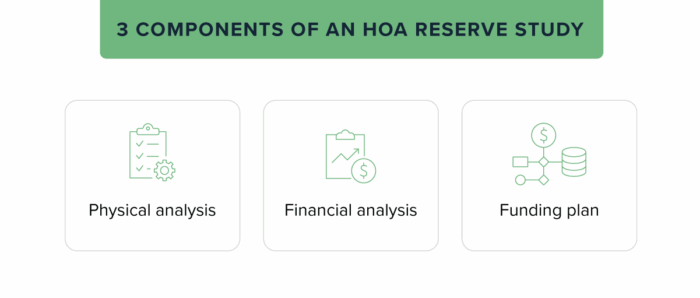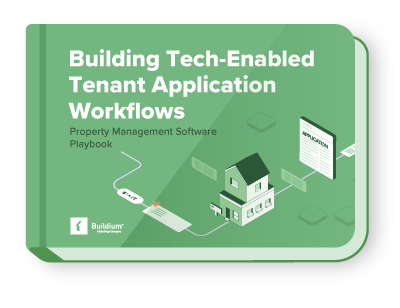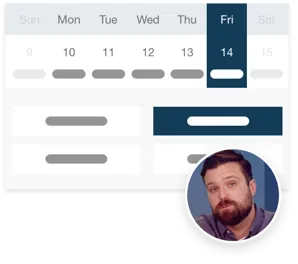An HOA reserve study might not sound exciting, but they’re one of the most important tools for keeping community associations financially stable. This assessment serves as a roadmap for any repairs and replacements that the HOA will need to make in the future. It helps you determine the steps you can recommend to improve the communities you manage.
Whether you’re preparing for your first reserve study for an HOA in your portfolio or brushing up on best practices, this post will give you useful advice. Here’s what you need to know to get started, and how to put your reserve study to work in your HOAs.
What Is an HOA Reserve Study?
An HOA reserve study is a budgetary planning tool for community associations. It helps them financially prepare for repairing and replacing shared elements they’re responsible for maintaining—and it includes three distinct components:

- Physical analysis: The physical analysis involves inspecting the common elements to determine their current condition and anticipated lifespan.
- Financial analysis: The financial analysis projects the cost of maintaining or replacing the common elements to keep them in good working order.
- Funding plan: The funding plan lays out a framework for how the community association anticipates being able to fund these expenditures without relying on supplemental sources.
Conducting regular HOA reserve studies is an important part of responsible reserve fund accounting. It provides a roadmap to plan for repairs and improvements and to keep the community’s finances stable.
When Should I Conduct an HOA Reserve Study?
According to the Community Associations Institute (CAI), some states have specific requirements for how often HOA reserve studies need to be conducted, while others do not. You’ll want to check your state’s current requirements to see how frequently you should be putting these studies on the calendar.
Even if your state doesn’t impose strict legal requirements, the CAI recommends conducting reserve studies at the time of construction, upon turnover of the community, and every few years after that. A full reserve study every three to five years is a good rule to stick to. Reviewing it annually can help keep your budgeting on track.
Preparing for an HOA Reserve Study
Once you know when to conduct your HOA reserve study, it’s time to start planning. Here are the steps you should take to do your due diligence.
Gathering Necessary Documents and Information
A reserve study doesn’t just look at the current physical condition of your community, it also takes into account historical information to get a better sense of where it stands. Before starting the reserve study process, gather any necessary paperwork that could be useful, including:
- Blueprints for the community
- The declaration and any other governing documents
- Copies of any previous reserve studies
- Current and historical maintenance records for all common elements
- Financial statements, such as the current budget and invoices for any work done on the common elements
Ideally, you’ll have a robust HOA accounting tool that can help you pull all the past financial information from the association together easily. If not, now’s the right time to set one up and get organized before moving forward.
Selecting a Qualified Reserve Study Professional
Because reserve studies are complex documents, you’ll likely want to hire a professional to take the lead. Industry organizations such as the Association of Professional Reserve Analysts (APRA) train specialists for jobs like these. Set aside time to find a qualified professional in your area who also has experience with your type of community.
Keep in mind that hiring an outside consultant will come with a cost. But, no matter what you spend, it will typically cost less and be less stressful than unexpected maintenance, compliance, or financial forecasting issues down the road.
Steps in Conducting a Reserve Study
Now that you know how to prepare for a reserve study, let’s break down the steps you’ll follow while conducting the study itself.
Step 1: Completing a Physical Analysis
A physical analysis of your community involves carefully assessing its current condition. You can do this by taking these actions:
- Create an asset list: Put together a comprehensive list of all the common elements in your community where the association is responsible for maintenance and upkeep. This will help make sure all pertinent assets get included in the reserve study.
- Conduct a site inspection: Spend some time inspecting any common areas and related facilities in your community. Be sure to document their condition with notes and photographs, paying particular attention to any wear and tear or obvious repairs that need to be made.
- Estimate the remaining useful life: If your community has done previous receive studies in the past, they will be particularly useful in helping you benchmark the remaining useful life of all your common elements, a metric that measures how long they will last before they require replacement. If not, you can ask your reserve study professional or a licensed contractor to provide you with estimates.
Step 2: Performing a Financial Analysis
Once you’ve finished the physical assessment of your community’s condition, the next step is to financially account for the repair and eventual replacement of all the common elements on your asset list based on their remaining useful lifespan.
Work with your reserve study professional to come up with estimates for the cost to maintain, repair, or replace all of these items. Old budgets and invoices can be helpful here. If you’re planning for a future expenditure, remember to take inflation into account.
Step 3: Evaluating Current Reserve Fund Status and Projecting Future Needs
After you have a total figure for what your anticipated expenditures will be over the length of your reserve study (which is often about 20 years), take some time to compare that number to where your current reserve fund stands today.
It’s okay and even a little expected to fall short on this metric from an HOA accounting perspective. Not all of these repairs need to be made immediately. Instead, they will often take place over several years.
The most important thing at this stage is to have a clear picture of your current reserves, your target amount, and a plan to get from one to the other.
Creating a Reserve Funding Plan
Once you have an idea of the amount of revenue you need to generate during your reserve study timeline, you can begin creating a funding plan. There are two man steps to creating this type of plan:
Determining Appropriate Funding Goals
First, you need to develop your funding goals. Since a reserve study’s scope typically spans a decade or more, you don’t have to worry about coming up with all the money right away. You should aim to have enough in reserves to cover the cost of replacing all your community’s assets around the end of their respective useful lives.
Your reserve study will give you a year-by-year breakdown of which community assets need to be replaced and what those replacements will cost. Use that information to come up with a target number for your reserve fund for each year included in the study.
Developing a Reserve Funding Strategy
Next, it’s time to come up with a comprehensive strategy for how you will reach your funding goals. The aim of a reserve study is to avoid relying on emergency sources of funding such as special assessments, and instead plan for steady growth that allows for these expenditures.
You could consider avenues like setting HOA dues at a rate that reflects the association’s benefits each year or adding additional amenities or services that can help create supplemental income streams.
Implementing and Maintaining the HOA Reserve Study
Once your reserve study is complete, it’s time to put your plan into action. Before moving full steam ahead, there are a few steps you can take to make sure your study stays accurate and useful over time.
Communicating Results with HOA Board Members and Residents
Your final report should include each of the components we’ve covered above, especially:
- Documentation from the physical analysis of the building’s condition
- A financial breakdown of repair and replacement costs for all common elements
- Funding estimates and your proposed plan
- A detailed project schedule
Once it’s ready, be sure to share the report with your board members, who will use it as a framework for budgetary actions going forward. It should also be made available for any residents who are interested in reviewing the information.
Regularly Updating the Reserve Study
Keep in mind that an HOA reserve study is not a static document. It should be reviewed and updated often to give your association the best chance at being prepared for large capital expenditures.
In addition to conducting a full reserve study every few years—or in line with your state’s requirements—you should:
- Review your reserve study annually to assess the health of your reserve fund and budget for upcoming expenditures
- Make updates whenever the association undergoes major renovations or adds a new amenity to its asset list
Best Practices for Conducting a Successful HOA Reserve Study
Like most HOA accounting best practices, a strong reserve study is simple in theory, but it takes planning and attention to detail. With a little forethought, you’ll end up with a more accurate and useful result.
Accurate Data Collection
You can’t have an effective reserve study without accurate data. Start by hiring a qualified professional who knows what to look for during both the physical and financial analysis. Be sure to vet providers through online reviews and referrals from other community managers in your area.
Involving Stakeholders
Reserve studies aren’t just for the board—they impact the entire community. Keep stakeholders in the loop through occasional updates in a portal or by hosting brief educational sessions about the reserve fund and how it’s managed. This helps build trust and shows residents that the HOA is planning responsibly for the future.
Common HOA Reserve Study Challenges and Solutions
No matter how careful you are during the reserve study process, there is a chance that your community could come up across some common challenges, including:
Addressing Funding Shortfalls
The reserve study should be reviewed often to try and catch funding shortfalls early, but if they do occur, there are a few paths you can take to raise the necessary funds:
- Re-evaluate the budget to identify where you can cut or postpone future expenses
- Increase HOA dues on an annual basis
- Ramp up your collection efforts on delinquent accounts
- Re-negotiate vendor contracts
- Levy special assessments, if necessary
Adjusting to Unexpected Repairs and Replacements
Similarly, if you have an unexpected repair or replacement expense, it’s a good idea to update your reserve study to accommodate it. Ideally, you’ll have enough funding in reserves to cover the cost, but if not you may need to update your project schedule to accommodate your new cash flow needs.
Software to Help with HOA Management
Keeping your reserve study up to date is a key part of responsible HOA management. But tracking expenses, managing documents, and keeping records accurate is no small task.
That’s where property management software such as Buildium comes in. With features built specifically for association management, Buildium’s comprehensive platform helps you stay organized with detailed financial reports, real-time expense tracking, and centralized recordkeeping.
If you’re ready to see how Buildium can help your community, sign up for a 14-day free trial (no credit card required) or schedule a guided demo today.
Read more on Accounting & Reporting

